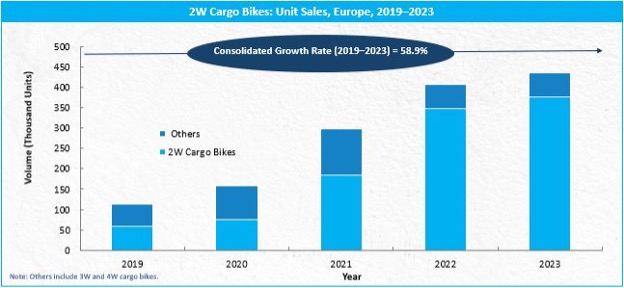Electric two-wheeler (e2W) cargo bikes gain appeal for personal use and last-mile delivery services, even as advanced connectivity and braking technologies enhance overall safety, efficiency, and performance.
Two-wheeler (2W) cargo bikes are gaining significant traction in Europe for both commercial as well as personal mobility purposes. Government subsidies and incentives, rising fuel prices, challenges related to urban traffic congestion, together with attributes of compactness, easier maneuverability and parking are underlining their appeal with last-mile delivery companies, many of whom are switching from vans to cargo bikes.

Meanwhile, individual users are looking to 2W cargo bikes to easily navigate and park in Europe’s densely populated cities. Many are looking to electric variants to benefit from reduced fuel and ownership costs. Lower initial costs are being helped by subscription models, such as those offered by Cargoroo, BAQME, and Avacargo, which allow users to pay based on their use of electric two-wheeler(e2W) cargo bikes.
Moreover, new technologies including anti-lock braking system (ABS), battery swapping features, and connectivity technology that support real-time location, anti-theft, 24/7 roadside assistance, and GPS features are increasing range and safety in e2W cargo bikes. In future, connectivity-enabled advanced rider assistance systems (ARAS) and blind spot detection are set to be introduced in e2W cargo bikes, further enhancing the riding experience.
To learn more, please access: Strategic Analysis and Growth Opportunities for Two-Wheeler Cargo Bikes in Europe, Global Two-wheeler Growth Outlook 2024, or contact [email protected] for information on a private briefing.
Strong Headwinds
The 2W cargo bike industry in Europe took off during the pandemic. From a 50:50 split between personal and commercial cargo bikes in 2019 to 75:25 in favor of personal usage, 2W cargo bikes are on an upward trajectory. Simultaneously, adoption levels have been spurred by regulations like the Urban Vehicle Access Regulations (UAVRs) of 2021 which have sought to control transport sector related carbon emissions.
Globally, Europe has the highest cargo bike sales, as most countries support their use to decrease reliance on cars. Germany, the Netherlands, and France together accounted for nearly three quarters of the 2W cargo bike market in 2023. Strong government support has been a major driver of demand in the countries.
Higher congestion charges across major cities in France, the United Kingdom, and Italy have highlighted the advantages of cargo bikes over vans since, unlike vans, cargo bikes are exempt from congestion charges and penalty fees for parking. This has resulted in a growing preference for cargo bikes for first- and last-mile delivery companies in urban areas.
Personal use of 2W cargo bikes is typically for school runs or shopping. Commercial use of cargo bikes, particularly since 2019, has focused on last-mile delivery in business-to-business (B2B) applications. In many cases, cargo bikes have replaced vans because of their multiple advantages including lower ownership and operational costs. For instance, e2W cargo bikes are estimated to save upto 60% in ownership costs compared to vans, and boost productivity rates by nearly 40% in comparison to vans.
Moreover, direct-to-consumer online sales means that e2W cargo bike manufacturers stand to maximize profits since dealerships are eliminated, while consumers can configure the bikes according to their preference.
Advanced connected technologies such as blind spot detection, advanced driver assistance system (ADAS) are improving the overall driving experience, while enhancing safety, efficiency, and performance in e-bikes are expected to come into e2W cargo bikes in future. Another technology that is improving driver safety are anti-lock braking systems (ABS), with Bosch and Blubrake leading the way with ABS for cargo bikes. Bosch, in fact, dominates the cargo bike space with more than 60% of all cargo bike companies in Europe deploying motors, batteries and displays manufactured by Bosch.
The question of payload capacity often crops up when comparing cargo bikes to vans. Here, trailers fitted onto cargo bikes can boost load capacity, with trailers being customized according to load capacity and size requirements.
Range anxiety is a major concern in the e2W cargo bikes space. Battery swapping has emerged as a promising solution since it allows for rapid swapping of a depleted battery for a fully charged one at charging stations. The provision of universal battery swapping stations, much like Swobbee does, will alleviate range anxiety and the spur adoption of eCargo and eBikes. However, underdeveloped infrastructure remains a focus area since it is insufficient at present to support likely demand.
Our Perspective
Governments will be key catalysts in driving e2W cargo bike use. From supportive policy and regulations to creating enabling infrastructure, they will play a major role in motiving wider e2W cargo bike adoption. Governments will need to collaborate with the private sector, OEMs, and other stakeholders across the 2W cargo bike ecosystem to fast-track its development.
e2W cargo bike manufacturers should follow the lead of companies like Gazelle and Urban Arrow to integrate a range of smart features that promote a superior driving experience. Partnering with Tier I suppliers like Blubrake and Bosch, will allow OEMs to provide safety enhancing features like ABS and adaptive cruise control. Furthermore, in partnership with battery-swapping companies, OEMs can improve affordability and accessibility by offering battery subscription as a Service (BaaS) to e2W cargo bike users.
e2W cargo bikes offer both environmental and economic benefits. However, realizing their full potential will require last-mile delivery companies and infrastructure OEMs to collaborate on expanding charging networks / battery-swapping stations. Here again, governments will play a crucial role in encouraging uptake of e2W cargo bikes by last-mile delivery companies by extending incentives and subsidies.
With inputs from Amrita Shetty, Senior Manager – Communications & Content, Mobility



